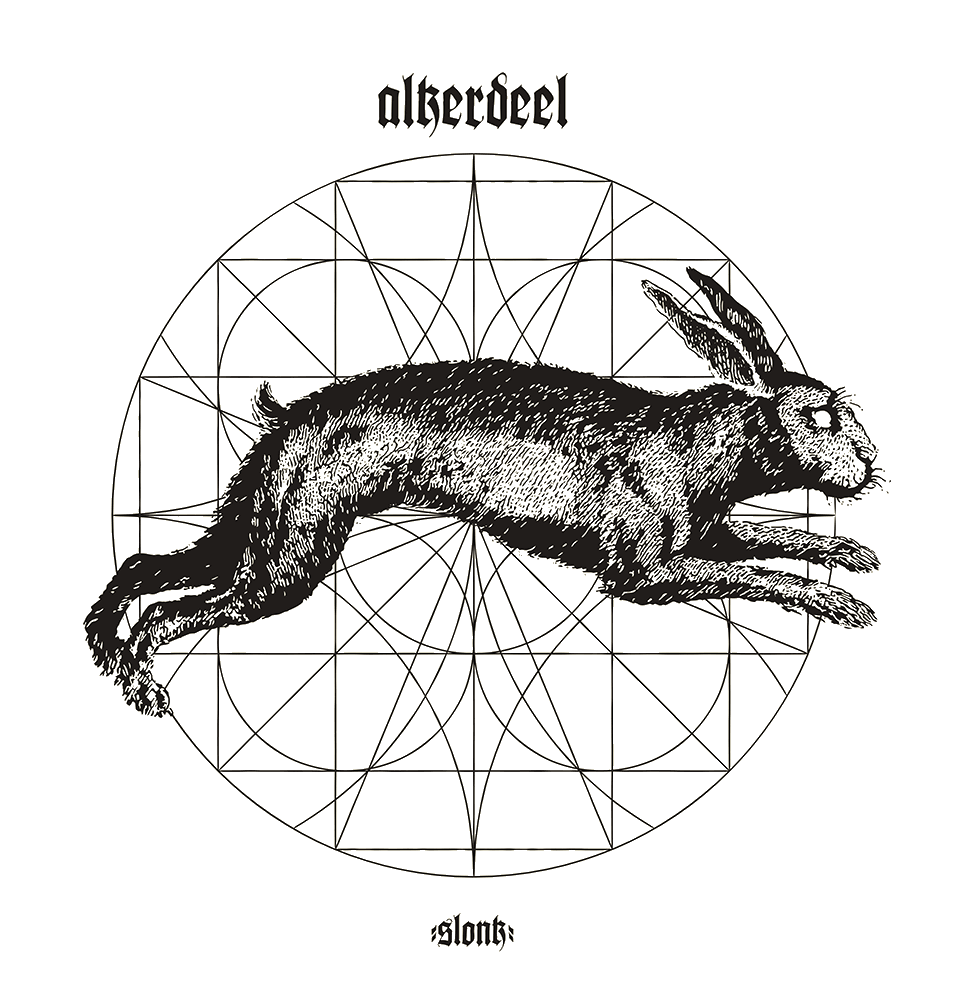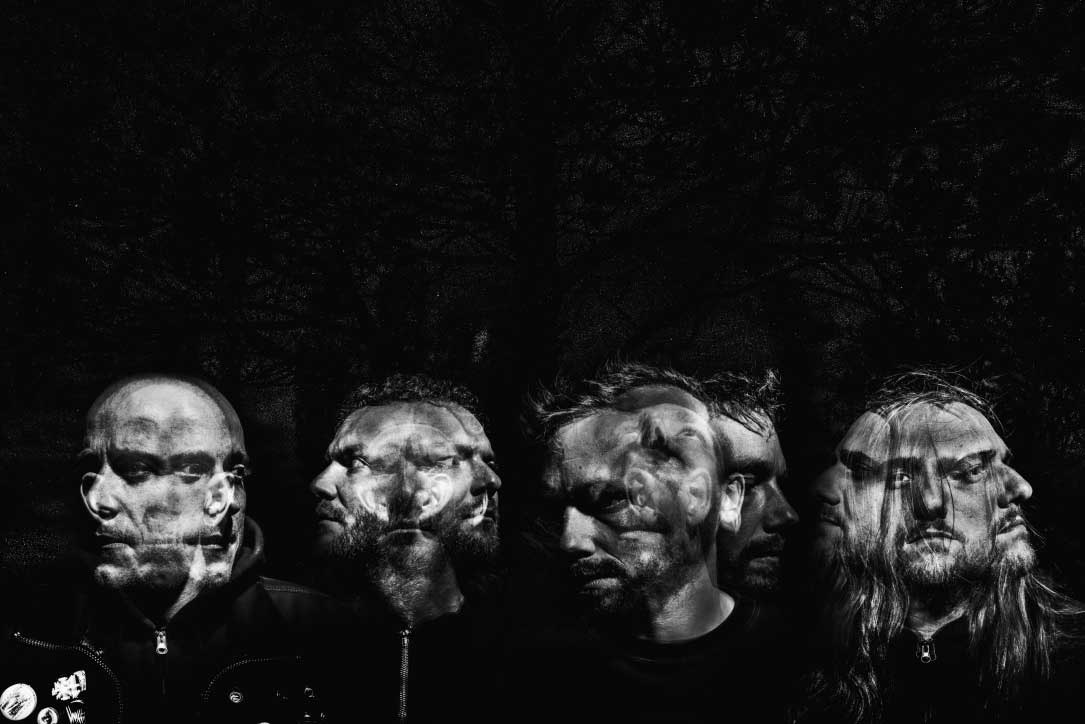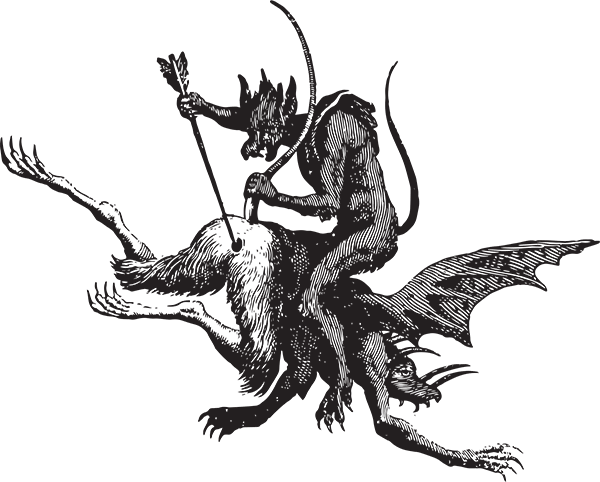Alkerdeel
2020-11-11
by Niklas Göransson
Multi-layered sonic surrealism: Alkerdeel is a black/doom quartet from Belgium striving to fuse the organic energy of a live performance with the permanence of studio recordings.
– With the new album, people were expecting our music to become even more brutal. “Slonk” is certainly aggressive in nature, but it also has atmospheric elements. I wonder if this development has something to do with touring alongside TURIA, a Dutch band with a distinctly atmospheric approach. They’ll probably deny it themselves, but to me they sound like a hybrid of early IN THE WOODS…, demo-era FLEURETY, FORGOTTEN WOODS, and such: classic acts we grew up with but never really highlighted in our own music before. Nevertheless, our hostility remains – aspects carrying heavy traces of old-school influences such as VON, BESTIAL WARLUST, ARCHGOAT, PARABELLUM, as well as certain kinds of death metal, like the MY DYING BRIDE demo.
“Slonk”, the fourth album of Belgium’s ALKERDEEL, was recorded in Boma Studio, Ghent, and is scheduled for release on February 5, 2021, by Consouling Sounds and Babylon Doom Cult Records. Besides his engineering skills, studio owner Frederik Segers also contributed an intro.
– Traditionally, for intros we’ve always worked with Maurice from GNAW THEIR TONGUES. We even made an album together called “Dyodyo Asema” (2013). However, “Slonk” needed something else. Frederik plays in STADT -– which is what you might call a krautrock band – and has a rich background in psychedelic music. We have a deal that’s been in play for most of our albums: I make designs for their projects, and in return we record in his studio. This time, it wasn’t only studio time we asked for, but if STADT could compose an intro for us. We did suggest a few lodestars to bear in mind, but there were no restrictions placed upon them.
Which references did you give them?
– Well, I’d love it if listeners could figure this out by their own accord, but here we go: NEPTUNE TOWERS, PINK FLOYD’s “Wish You Were Here”, the intro to IN THE WOODS… “Heart of the Ages”, Jean Michel Jarre “Oxygène”, the outro to JOYLESS “Unlimited Hate”, and a street singer from Prague called Jiří Wehle. Furthermore, never before have I taken the relation between artwork and lyrical content as far as I did with “Slonk”. That’s why, for the first time, the lyrics are included; they are necessary in order to understand the interplay between booklet images and song titles. At the same time, they contain a lot of hidden details, metaphors, and inside-information that can be difficult to comprehend – some of them in local dialect, making it a challenging read even for native Dutch speakers. Each song title represents one of the four elements, although this is not what the lyrics are literally about. The booklet contains four different animals that can be found locally here in the wide fields: a hare, a pheasant, a toad, and a bombardier beetle. All chosen to fit the four elements.

Besides representatives of the local fauna, the booklet also contains photography with what one might call a distinctly rural feeling.
– My sister has a huge collection of photos taken during her wanderings close to where we rehearse, which is on a farm in an old barn – the cow stable, to be precise. Actually, it’s the same area LUGUBRUM originally hail from. They invented the moniker ‘boersk blek metle’, farmer black metal, and since we’ve hooked up with them quite a few times by now, some people have started putting that tag on us. Which is bullshit; it’s their thing, not ours. But we never hide our agricultural origin, of course, and this legendary befriended band might have been a subconscious influence.
Pede has mentioned Belgian surrealism as one of ALKERDEEL’s influences. I know next to nothing about the matter, but I’m curious if this artistic heritage is the reason why there’s so much weird metal from Belgium – with the aforementioned LUGUBRUM as a prime example.
– You’re totally right about LUGUBRUM, and you might also mention PERVERTED CEREMONY and, to some extent, MOENEN OF XEZBETH. The latter aren’t overly original, in that they recapture the sounds of yore, but they do not follow any rules whatsoever – they make their own. Surrealism has always been synonymous with anarchism, not adhering to any framework, and generally being a trickster. I wouldn’t say we’re directly influenced in the same way, but we’ve certainly studied the works of Belgian artists. Take for example the famous work of Magritte that shows a pipe, with ‘Ceci n’est pas une pipe’ written below. This explains a lot.
In 1929, surrealist artist René Magritte created The Treachery of Images – a painting which depicts what does indeed appear to be a pipe, but with ‘This is not a pipe’ written beneath. Questioned about the logic, the painter famously encouraged his detractors to try to stuff the pipe in question with tobacco. This would obviously be a fruitless task, he said, seeing as how it’s merely an artistic rendition of a pipe; as such, claiming otherwise would’ve been a lie.
– Although you can clearly see the pipe, the written line leaves you in doubt. It demonstrates how humans can only cope with reality by directly describing it through symbols or language. We are drawn to things we recognise and relate to. Maybe it’s a big leap, but, when creating music, we are the opposite. This explains why ALKERDEEL takes such a multi-layered approach – the wall of sound. Of course, we like both IRON MAIDEN and DISSECTION, but their melodies are what they are; there is very little room for interpretation. Even if we had their level of talent, we’d never create something the way they did. To us, it’s more compelling with elements which can’t be clearly heard: subtones. The things happening in the gutter. The smelly mud that gets squeezed through the ribs of your shoe soles whilst walking through the fields. That is interesting. There’s something very stubborn inherent in us Belgians though… some people relate it to the fact that we’ve always been under foreign control, or the host of battles fought in wars contested by other countries.

Far be it from me to criticise creative use of language in a metal context, but there are limits to my tolerance. I noticed whilst researching that ALKERDEEL used to present themselves as, trigger warning, ‘filthyblacksludgedronedoom’. Yes, without blank spaces. Thank heavens I was unaware of this when solicited for the interview, or we probably wouldn’t be having this conversation.
– Haha! Phew, glad we stopped using this a couple of years ago then. We never considered it offensive, it was somewhat carelessly applied just to sum up what we sounded like. These days, I quite understand why it would make you cringe. When we first started out, the mentioned styles were all part of our basic musical foundations. What’s known today as ALKERDEEL initially started out as a rehearsal project around 2005 – courtesy of myself, drummer Nieke, and guitarist Pui. Those two have been making music together ever since childhood; both of them played in HEADMEAT, a death metal band that released an album on Killjoy’s Baphomet Records.
Bass player QW joined later; he has a background in SERPENT CULT and THEE PLAGUE OF GENTLEMEN.
– As for myself, I’d never been in a serious band before. I did have some projects, but my primary involvement was behind the scenes. The saxophone is the only instrument I’ve ever bothered to learn, yet I never considered it useful for the kind of music I liked. I was massively into tape-trading, and, after some years – around the turn of the millennium – a local friend and I started Noise Magazine. We did two printed ‘zines and then, for some reason, had a brief stint online. Actually, the printed editions already show our exotic tastes: GRAVELAND and THE THIRD EYE FOUNDATION in the same issue was quite eclectic even back then, if I may say so. Eventually, I got fed up with it. We were still young, and perhaps the arrogant style of Nordic Vision echoed too much in our reviews; it started feeling disrespectful to the musicians, regardless of how bad their work was.
During the mid to late 90s, Norway’s Nordic Vision was one of the premier publications in underground metal. It became especially renowned for editor Melankol X’s savage and ruthless reviews, as well as the reactions of certain bands subjected to them.
– Most of my closest friends at the time played in bands; I had a huge car, so I became their personal roadie and chauffeur. It was a fourteen-year-old Volvo 240 which had previously served as an intervention ambulance: white with red stripes on the sides and a massive red cross over the roof. Very amusing when arriving at venues. I drove them a lot, so I witnessed shitloads of crappy bands: mostly technical death metal or, even worse, metalcore. In the end, my weekend evenings typically consisted of bemoaning all the terrible bands we were exposed to. My personal interest was within second-wave black metal and old doom in the vein of early PARADISE LOST or bands like BURNING WITCH and IRON MONKEY. Back then, there was not a single chance to catch any of this live. Ever. Most of the bands I liked either didn’t exist anymore or had already started playing a more easy-listening style. Besides the biggest acts, or the occasional Metallysee tour, the only black metal available locally sounded like bad MARDUK or SETHERIAL clones.
In the 90s and early 00s, Belgian booking agency Metallysee were one of the most prominent tour organisers for black and death metal in mainland Europe. They were behind many classic tour packages, such as the No Mercy and X-Mass fests.
– However! Due do tape-trading and a legendary metal pub in Ghent called The Frontline, I got to know Pui and Nieke. Their band, HEADMEAT, played quite a few gigs together with WELKIN – and after hanging out a few times we discovered our similar taste in music. So, we started a project together, which felt like a far more constructive approach than just whinging about everyone else. There was very little in terms of ambition besides playing for ourselves, and our music was not limited to a genre; the only restriction was to play ‘dirty’ music exclusively. Everything from ILDJARN and BEHERIT to EYEHATEGOD and similar, but also more obscure stuff like MERZBOW.
MERZBOW is an iconic Japanese noise band, known for its penchant for visceral sonic torment. Since the project’s conception in 1979, driving force Masami Akita has churned out over four hundred releases and participated in numerous artistic collaborations.
– I was in art school during that period and had some friends who were into noise. Such influences even snuck into our first two albums: I used to manipulate my voice with a Memory Man delay pedal. You can hear this a lot in the eerie background noises on “Du Levande” from the “Morinde” album. I eventually got fed up with sitting on my knees, turning buttons, during rehearsals and gigs so I abandoned this. But that’s how we got started, being only a rehearsal project. We actually went by a different name back then and considering how much you hated ‘filthyblacksludge…’, you’re likely to loathe this one ever more. We called ourselves DARK TORRE, as a reference to DARKTHRONE. ‘Torre’ being a dialect word in Dutch for ‘fart’.
I think it might be in everyone’s interest to swiftly move the conversation along.
– We meant nothing serious by it, just a name for what at the time was merely a recreational project. People around us grew interested though, and a local promoter even asked us to play live – despite being aware that most of our stuff was sheer improvisation based on the few riffs we could remember from jams. He came by the very last time we rehearsed before the gig, following which his face adopted the same sheen as those adventurous enough to open a can of Swedish surströmming. Come showtime, we played one long song: a hybrid composition made from parts of ILDJARN and DARKTHRONE blended with our own material. Unsurprisingly, it was alienating to roughly seventy-five percent of those in attendance… most of whom were into grind, death, and, again, metalcore. Nonetheless, we got superlative feedback from people who were relevant to us and things grew more serious. We changed our name to ALKERDEEL but kept the improv-based work ethic intact.

Can you explain how this improvisation works?
– Mind you, it’s none of this free-jazz improv: just riffs after riffs where drums and voice contribute accordingly. We taped these jams on a Dictaphone and after hearing one such recording, Blesken of SILVESTER ANFANG and Funeral Folk – who also recorded our debut – asked if he could give it a proper tape release. It received surprisingly good feedback in underground circles, which I still find weird given its incredibly rough sound, so much so that Scottish label At War With False Noise offered to give it a proper CD release. Even Profound Lore showed brief interest around the time. What did evolve was that we started treating our music differently, not wanting to come off as some tribute band. We still wear our influences on our sleeves, but we try to do our own thing and sound different. People say they can’t detect anything from some of the bands we reference: DÄLEK, for example, which is a dark industrial hiphop band you’d never link to us. However, they had a direct impact on the atmosphere and drumbeat of “Hessepikn” from “Morinde”. I never understood why all of one’s inspirations should be heard upfront.
How were you drawn to such odd sounds to begin with?
– As a kid, on Sunday mornings I’d always be awakened by my dad playing loud blues music. Not Eric Clapton, but more the Robbert Johnson kind-of-blues; recorded with one mic only and probably cut in Bakelite by some granny’s toenail. That music, with its primitive and hollow sound, always stuck with me. Although it sounds crappy, it’s very honest. It evolved from slave music by musicians with nothing more than a guitar at their disposal. Although ILDJARN doesn’t share the blues elements, the core remains the same. There is no room for tricks. ILDJARN, at least in spirit, reminds me of how Robbert Johnson must have recorded his songs. Their motivations, by intention or limitation, are irrelevant to me. EYEHATEGOD represent the New Orleans suburb side of society – junkies, essentially – whereas ILDJARN is a straight-edge vegan from the Norwegian forest. Miles apart geographically, yet so close to each other in sound. Both equally misanthropic. That’s why the combination works so well. Actually, tying heavily into our musical approach, there’s this letter from Steve Albini to NIRVANA, replying to their offer for him to record “In Utero” and his answers are quite fun to read.
When asked to handle the recording of NIRVANA’s third and final album, Albini cautioned, ‘If a band considers the recording to be a controlled layering of specific sounds, each of which is under complete control from the note is conceived through the final mix … well, my approach is exactly the opposite.’
– We know some people who recorded with Albini, and they revealed that he says not a single word about the music. No approval, no rejection. He sits there recording, without adjusting a thing. ‘You sound how you sound’, he says. ALKERDEEL relates a lot to that. Albini’s work with BURNING WITCH – an old doom band with Stephen O’Malley and Greg Anderson from SUNN O))) – and especially the song “The Bleeder”, might be termed one of our holy grails regarding sound. We’re certainly not there yet. How an LP sounds on itself is one thing, but also how different a band can sound live if you compare it to their records. As a performing musician myself, I’m well aware of the live limitations; however, that’s not what I mean. I point more to the atmosphere, the ability to recreate something as mythical as you do on a studio album. Or the other way around. Our aim is to get our rehearsal, live and studio output to become as closely linked as possible.



